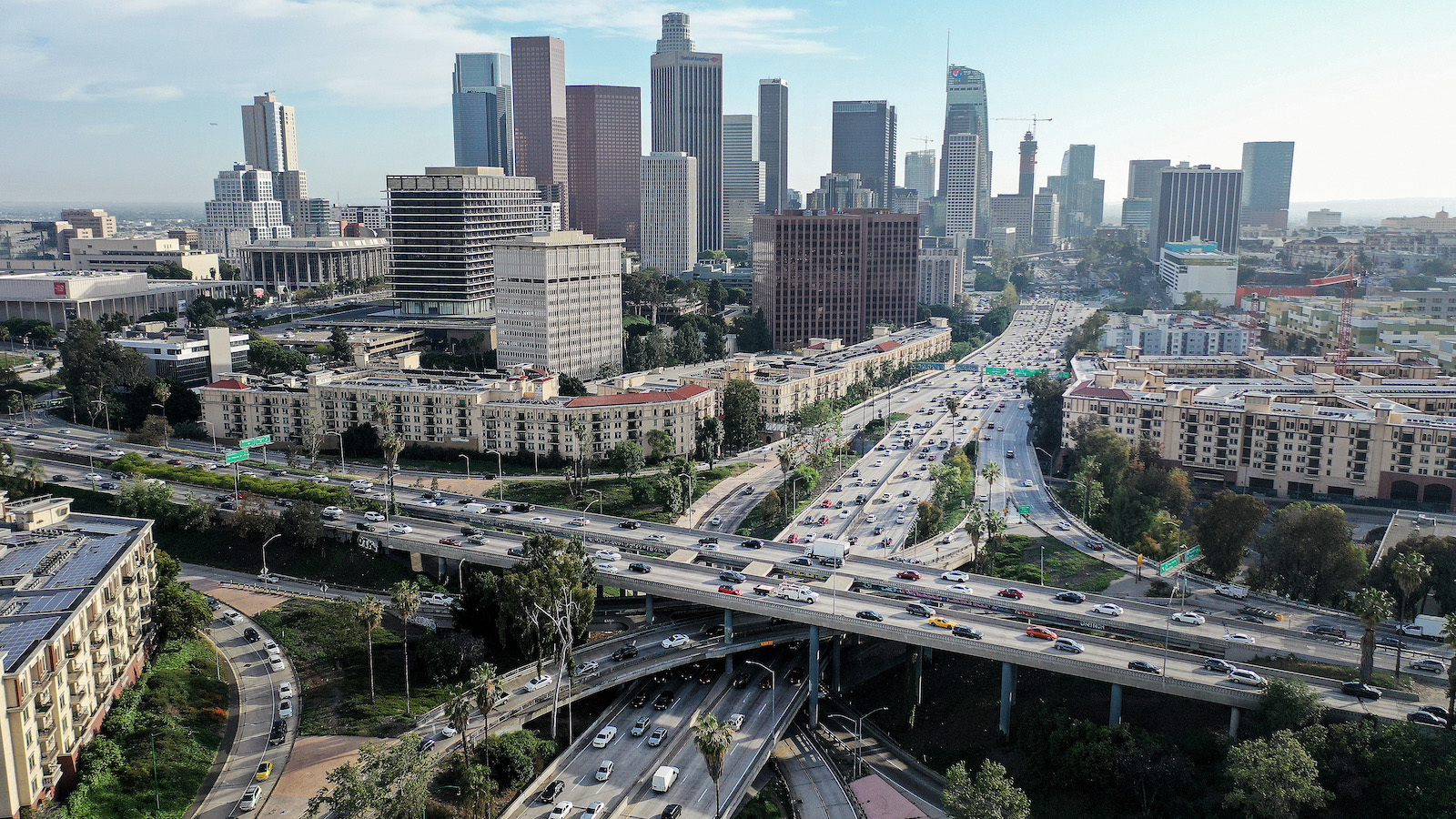In the event you lived within the suburbs within the Nineteen Seventies, you may see it in your thoughts’s eye: driveway after driveway crammed with Nation Squires and Pontiac Safaris and Buick Property Wagons. The Silvermans, for example, with whom we shared a double-driveway within the Boston suburb of Lexington (“birthplace of American liberty”) and who, on a heat summer time night, would pile all the youngsters in again and all of the adults in entrance and drive off two or three miles to Buttrick’s ice cream stand. Once I say the youngsters piled within the again, I imply we crammed into the again cargo space — and, if reminiscence serves appropriately, on the again roads Mr. Silverman would truly decrease the tailgate and allow us to dangle our legs over the again. For sure all of this is able to now get you arrested for little one endangerment, however we beloved it. Cherished it with out fascinated with it, as a result of the automobile was absolutely the unquestioned actuality of our lives.
People had, after all, been shopping for automobiles in huge numbers since Henry Ford began up his meeting line in 1913, however till the tip of World Struggle II the numbers weren’t that huge: in 1950 there have been solely 25 million automobiles registered within the nation. That summer time, over Lexington, a fleet of seven skywriting planes puffed out a gasoline commercial within the sky: “New Blue Sunoco,” it stated, day after day.
The message took — all such messages took. U.S. factories produced 8 million new automobiles that 12 months, and by the tip of the last decade there have been 67 million automobiles on the roads of America. These roads stretched all over the place, because the Fifties additionally noticed the development of the interstate freeway system, the biggest public works program in American historical past. I’d by no means left the continent until nicely previous school, however I’d seen an terrible lot of the US: trip meant piling into the automobile and driving, masking floor alongside the route that somebody within the AAA workplace had highlighted in our TravelGuide, till about 5 within the afternoon when it was time to seek for a motel (the TravelGuide image for a swimming pool was an absolute requirement.)
By 1970, there have been 118 million automobiles on the highway within the U.S. — greater than quadruple the quantity 20 years earlier than.
It took no time — a decade — for America to assemble itself across the automobile. That’s what the suburb was, a mirrored image in concrete and wooden and brick of the logic of the auto, designed for its dimensions, its turning radius. Lexington was an older and extra compact suburb, so it was theoretically attainable to barter it with no automobile — however probably not. We shopped on the mall one city over, and so far as I do know nobody had ever approached it on foot; why would you? And the additional out you went, the extra car-centric the suburbs grew to become, only a sequence of branching roads that ultimately become driveways.
Greater than three-quarters of People drove to work, and most of them drove by themselves. As Meg Jacobs wrote in her historical past of the interval, by 1970, People consumed a 3rd of the world’s vitality — greater than the Soviet Union, Britain, West Germany and Japan mixed. And largely due to the automobile. By then there have been 118 million automobiles and vans on the American highway — greater than quadruple the quantity 20 years earlier than. The automobiles had been huge: 20 p.c greater than they’d been simply 5 years earlier than. Three-quarters of them now got here with air-con (up from 20 p.c in 1960), which subtracted about two and a half miles a gallon from the gasoline effectivity, not that that was a factor anybody even thought of in 1970, as a result of gasoline was 36 cents a gallon.
I received my learner’s allow the day I turned 15 and a half, and naturally I sat by means of driver’s ed, with its interminable movie strips about youngsters who took a bewildering number of medicine and subsequently crashed their automobiles. We practiced on a driving simulator, after which on the highway with a baseball coach supplementing his pay — he directed me to merge on to the freeway at 70 miles per hour 4 minutes into my driving profession. I beloved it, and never simply because automobiles meant intercourse. (We actually referred to as it ‘parking.’) As a result of it meant financial freedom: you may work, so as to get cash to purchase gasoline.
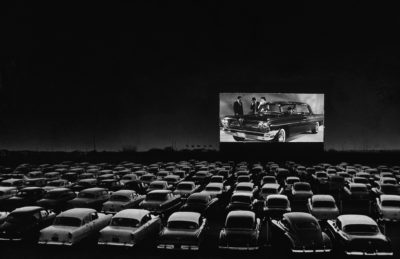
Automobiles fill a drive-in theater, Fifties.
New York Occasions Co. / Hulton Archive / Getty Photographs
However my work was as a really cub reporter for the native chain of suburban weekly newspapers, and the story that I lined greater than some other was: the sudden, violent collision between that automobile tradition and world geopolitics. I used to be too younger to actually pay a lot consideration to the primary oil shock in 1973, although I used to be conscious that there have been instantly lengthy strains at Al’s Gulf. However by all accounts it was unhealthy: at one Texaco station on the town, the proprietor reported “they’ve damaged my pump handles and smashed the glass on the pumps, and tried to start out fights once we shut.” Nixon ordered a ban on vacation lights — and even when he scaled again the order, companies might solely put up a few fifth of the atypical spectacle. The Daytona 500 was reduce to 450 miles; one White Home official traded in his chauffeured limousine for a chauffeured Ford Pinto. However in March of 1974 Saudi Arabia lifted the embargo that had triggered the primary oil disaster; costs stayed excessive, however life resumed: the momentum of suburbanization hadn’t been damaged, although at the very least for some time automobiles downsized — we by no means had something fairly as long-nosed as that Plymouth Fury once more.
I used to be solely aware, nevertheless, when the second oil shock hit, this time in 1979 after the Iranian Revolution led to sharp drop within the oil provide. The gasoline strains returned, and I used to be 18 and masking them for the native paper, making limitless rounds of calls to native filling stations to see after they’d be open and for a way lengthy, so we might print the schedules on the entrance web page. “Everyone seems to be close to 75 p.c allocation, which suggests one out of 4 folks will not be going to get gasoline, and nobody desires to be that one,” the proprietor of the Shell station advised me. “I open at 7 a.m., and I’m pumped out by 11 a.m.” He was nice, anyway. “Hours? We now have no hours,” somebody answering the telephone at Dom’s Amoco snapped. “I pump gasoline once I really feel prefer it.” One among my duties was the police log, usually a reasonably dry affair however now instantly crammed with studies of individuals arrested for siphoning gasoline out of automobiles parked in driveways. I interviewed faculty officers, who had been busy repairing boilers (“we’re stretching a gallon of gasoline oil to its limits,” the top custodian defined) and automobile sellers (“huge automobiles are lifeless,” one VW supplier stated).
“No one can embargo daylight,” President Carter stated. “No cartel controls the solar. Its vitality won’t run out.”
Together with gasoline station homeowners, I additionally received to interview the quantity three official within the nation’s vitality division. John Deutch was an MIT professor, and in between Washington stints he lived in Lexington, so I talked with him the week earlier than his boss, President Jimmy Carter, was to present a nationwide tackle on vitality conservation. Deutch — barefoot and in denims on his again porch — was sounding appropriately sober. “In the event you’re an individual in a state of affairs the place there’s too little oil, you’ll search for simple options and for scapegoats,” he stated. “However there isn’t a fast repair. There isn’t a query about the truth that till the American folks perceive that there’s not as a lot oil as they need at costs they need, there will probably be issues.”
Carter had been placing the identical notice all alongside: in his first tackle as president he’d stated “we have now discovered that extra will not be essentially higher; that even our nice nation has its acknowledged limits.” The vitality disaster, he stated, was a reminder that “ours is essentially the most wasteful nation on Earth.” Because the gasoline strains grew longer, his sobriety deepened. “All of the laws on the planet can’t repair what’s fallacious with America,” he stated. “Too many people now are likely to worship self-indulgence and consumption,” he stated, sounding totally different than any president had ever sounded. We must always change — we should always study “that proudly owning issues and consuming issues doesn’t fulfill our eager for which means, that piling up materials items can’t fill the vacancy of lives which don’t have any confidence or goal.”
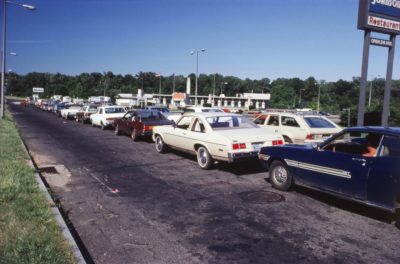
Automobiles line up at a gasoline station in Darien, Connecticut in the course of the 1979 oil disaster.
Bob Riha, Jr. / Getty Photographs
If that appeared like an assault on suburbia, nicely — it form of was. Or, if not an assault, then an invite to suppose a bit of otherwise. And an invite which may, truly, have been answered. The Nineteen Seventies had begun with the publication of a ebook referred to as Limits to Progress, an argument that we had been reaching ecological boundaries that grew to become one of many bestselling nonfiction volumes ever. A 12 months later E.F. Schumacher had produced Small is Lovely — a ebook so highly effective that when its German-British writer got here to America, Carter hosted him on the White Home. The sociologist Amitai Etzioni was a senior coverage advisor in that White Home, and he introduced the president polling knowledge to point out how up within the air the nation actually was; the info confirmed 30 p.c of People had been “pro-growth,” 31 p.c had been “anti-growth,” and 39 p.c had been “extremely unsure.” That form of ambivalence, he advised the president, was “too annoying for societies to endure,” and he was proper — which explains, I believe, the fateful 1980 election once we turned to Reagan and his markets-solve-all fundamentalism and thus started the trail towards our present state of overheated dysfunction.
What may we have now executed otherwise within the Nineteen Seventies, even earlier than we actually understood the hazard that carbon dioxide was posing? It seems that, in these oil shock years, the Carter administration fastened on one key resolution: large authorities help for growing solar energy. “A robust photo voltaic message and program,” the president’s home coverage advisor Stuart Eizenstat advised him, “will probably be necessary in attempting to counter the hopelessness which polls are exhibiting the general public feels about vitality.” Carter agreed to the plan — certainly, he stated a fifth of the nation’s vitality ought to come from solar energy by 2000. He referred to as for spending a billion {dollars} in fiscal 12 months 1980 to create a Photo voltaic Financial institution to fund analysis and to supply owners with loans for placing up panels. He formally declared Might 3, 1978 as Solar Day and noticed this primary photo voltaic vacation by touring to a mountaintop in Golden, Colorado, residence to a federal photo voltaic analysis facility: “The query is now not whether or not photo voltaic vitality works,” he advised a crowd. “We all know it really works. The one query is methods to reduce prices in order that solar energy can be utilized extra broadly and set a cap on rising oil costs. In lots of locations, photo voltaic heating is as economical right this moment as energy from nonrenewable sources.” He added, “No one can embargo daylight. No cartel controls the solar. Its vitality won’t run out. It won’t pollute our air or poison our waters. It’s free from stench and smog. The solar’s energy wants solely to be collected, saved, and used.”
In 1986 the Reagan administration took the photo voltaic panels down from the White Home roof and saved them in a warehouse.
After which a 12 months later he did one thing much more necessary: on June 20, 1979, he invited dignitaries and reporters onto the roof of the White Home to look at the set up of 32 photo voltaic hot-water heating panels. “A era from now,” he stated, “this photo voltaic heater can both be a curiosity, a museum piece, an instance of a highway not taken, or it may be a small a part of one of many best and most fun adventures ever undertaken by the American folks.”
In fact, it took a lot lower than a era to ship the decision: literal museum piece. Shortly after taking workplace, Reagan reduce the renewable vitality analysis funds by 85 p.c and let the tax credit for photo voltaic panels expire; he did away with help for weatherizing houses, and ended vitality effectivity necessities for home equipment. As a substitute, Reagan pushed exhausting for elevated oil drilling within the U.S. and for ensuring that no pesky laws received in the way in which. “First, we should resolve that ‘much less’ will not be sufficient,” he stated. “Subsequent, we should take away authorities obstacles to vitality manufacturing. Placing the market system to work for these goals is an important first step for his or her achievement.”
And so in 1986 the Reagan administration took the panels down from the White Home roof and saved them away in a Virginia warehouse. A high White Home official thought the gear was a “joke.” An official spokesman stated “placing them again up could be very unwise, based mostly on price.”
Because it occurs, I do know a bit of about these panels. They had been rescued from that Virginia warehouse by a college member at Unity Faculty, a small faculty in a rural nook of Maine, the place for years they sat on the roof of the cafeteria, heating the water used within the kitchen. They gave away or offered just a few of them: I discovered about them in 2008 once I visited the Solar Moon Mansion, the headquarters of China’s largest photo voltaic sizzling water firm. Huang Ming, who’d based the corporate, saved certainly one of Carter’s panels in a spot of honor in a small museum of renewable vitality simply off his government workplaces. The panels, he stated, had helped encourage him to create a enterprise that was presently heating the water for 1 / 4 billion of his countrymen — some Chinese language cities, considered from the air, look as if each single constructing has a photo voltaic sizzling water heater on high.
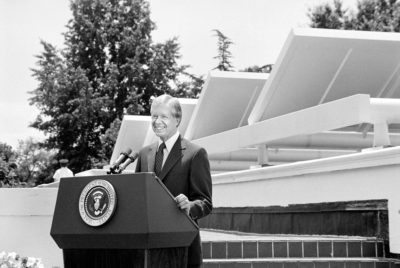
President Jimmy Carter in entrance of photo voltaic panels on the roof of the White Home, June 20, 1979.
Common Historical past Archive / Common Photographs Group through Getty Photographs
Anyway, Unity officers agreed at hand me a pair extra of the historic panels, and so in 2010 I rented a van, hitched a trailer behind it, and commenced dragging them south towards the White Home. It was a enjoyable highway journey — three college students and a professor from Unity had been alongside. We hosted rallies in Boston, New York, and Baltimore — we’d pour a gallon of water within the high of the heater, level it on the solar, and eight or 9 minutes later steam could be churning out: 31 years later this stuff labored in addition to the day they went up. Our hope, after all, was that Barack Obama (whom all of us had labored to elect) may symbolically reinstall one, up high of his new home. We thought it made sense: when the primary girl had planted the White Home backyard a 12 months earlier than, seed gross sales had gone up 30 p.c. We thought that the present may assist the administration restart photo voltaic historical past after three many years.
However no. Arriving in Washington, we had been directed by administration officers to a aspect door on the Government Workplace Constructing — the 5 of us had been ushered by an intern in a blue blazer into the wood-paneled room the place, as soon as, the UN Constitution had been drafted. This present day, a trio of what The New York Occasions referred to as “midlevel White Home” officers met with us, within the single most irritating instance of bureaucratic obstruction I’ve ever gotten to witness shut up. First they filibustered — lengthy boilerplate explanations of how the administration was “constructing an even bigger, higher, smarter electrical grid, all whereas creating new sustainable jobs.” I sat again and let the three college students reply, they usually had been magnificent. “Thanks in your good work,” they stated politely, again and again. “However nobody actually is aware of about it — definitely not our associates, who voted for Obama however are more and more disillusioned. What higher approach to unfold the phrase about what you’re as much as than the high-profile transfer of placing photo voltaic panels again on the roof?”
No, stated the officers, however they refused to say why. Actually refused. The scholars requested, repeatedly, and the lady who was main the dialog saved repeating the identical phrase: “If reporters name and ask us, we’ll present our rationale.” However they wouldn’t present it to us, they usually wouldn’t pose for an image with the scholars, they usually wouldn’t settle for the outdated panel even to place in storage.
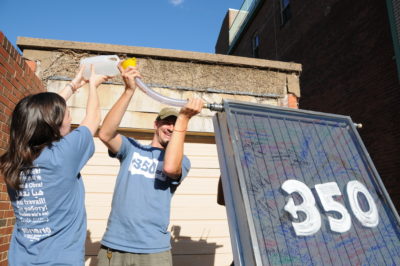
Jean Altomare and Jesse Pyles of Unity Faculty reveal one the unique water-heating photo voltaic panels put in on the Carter White Home.
350.org through Flickr
Finally we had been again on the sidewalk, and the three school college students had been speaking to reporters. They had been in tears — of disappointment, but additionally I consider real perplexity. Amanda Nelson: “I didn’t anticipate I’d get to shake President Obama’s hand, nevertheless it was actually stunning to me to search out out that they actually didn’t appear to care.” Elliott Altomare: “We went in with none doubt concerning the significance of this. They handed us a pamphlet.” Measured the way in which activists measure issues, it was solely value it: three tales within the Occasions, loads of different protection. We’d moved the needle a bit of additional alongside. However I felt a bit of responsible about disillusioning these college students: they’d seen early on among the cowardice and ethical compromise inherent in holding energy. And — for all my superior years — I felt a bit of disillusioned too. It definitely made it simpler to return again to the White Home the subsequent 12 months and assist set up the protests in opposition to the Keystone XL pipeline that led to the mass arrests of demonstrators. In time we received that battle: we compelled Obama to dam KXL, the primary lack of that sort Huge Oil had ever suffered. And in time — safely into his second time period — Obama did certainly put photo voltaic panels up on the White Home roof. “The mission, which helps reveal that historic buildings can incorporate photo voltaic vitality and vitality effectivity upgrades, is estimated to pay for itself in vitality financial savings over the subsequent eight years,” a spokesman stated.
Looking back, it was fairly clear why Obama needed nothing to do with these photo voltaic panels: they had been tainted by their affiliation with Carter. The 1980 election, 30 years later, nonetheless dominated our politics. We’d made a selection then, and that selection nonetheless held sway, even within the administration of our first Black president, a person who on the eve of his nomination had stated that future generations would look again on that point as “the the second when the rise of the oceans started to gradual and our planet started to heal.” However he calculated that we hadn’t but reached the second once we might transfer previous that earlier second in our political historical past. Right here’s how Obama put it lately: “By means of how I thought of these points once I first got here into workplace, I believe there was a residual willingness to just accept the political constraints that we’d inherited from the post-Reagan period,” he stated. “In all probability there was an embrace of market options to a complete host of issues that wasn’t solely justified.” In all probability.
This text is customized from Invoice McKibben’s new ebook, The Flag, the Cross, and the Station Wagon.
